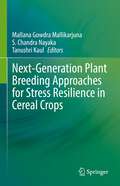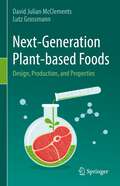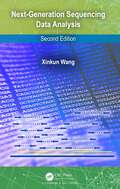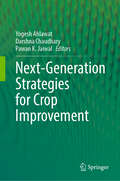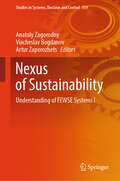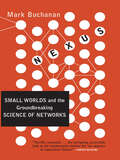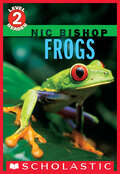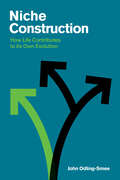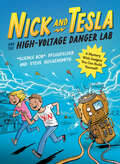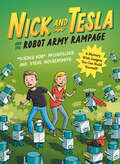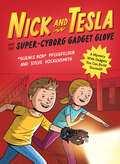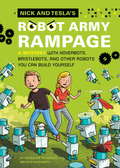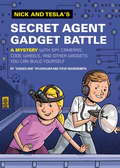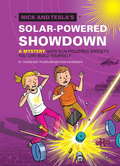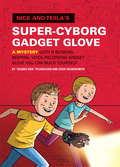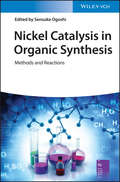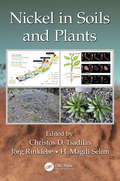- Table View
- List View
Next-Generation Plant Breeding Approaches for Stress Resilience in Cereal Crops
by S. Chandra Nayaka Mallana Gowdra Mallikarjuna Tanushri KaulThis edited book highlights the gravity and efficacy of next-generation breeding tools for the enhancement of stress-resilience in cereals, especially in the context of climate change, pests, diseases, and abiotic stresses. The content of the book helps in understanding the application of emerging genetic concepts and neoteric genomic approaches in cereal breeding. It collates all the latest information about enhancing the stress resilience in cereal crops for overcoming food security issues. Cereals have predominantly been used as a staple food since time immemorial and contribute more than 50% of the caloric requirement of the global population. However, in cereals, the yield losses due to various stresses are very high, considering the crop growth stage and stress sensitivity. Therefore, to feed and nourish the generations in the era of climate change, it is imperative to develop stress-resilient cereal cultivars. This book explores newly developed next-generation breeding tools, viz., genome-wide association studies, genomic prediction, genome editing, and accelerated generation advancement methodologies, which revealed promising outcomes by enhancing the stress resilience in cereals with yield potential. This book is useful for postgraduate students specializing in plant breeding, plant stress physiology, plant genomics, agriculture, and agronomy. It is of immense value to scientific community involved in teaching, research, and extension activities related to cereal cultivation.
Next-Generation Plant-based Foods: Design, Production, and Properties
by David Julian McClements Lutz GrossmannThe creation of plant-based foods is one of the most rapidly advancing areas in the modern food industry. Many consumers are adopting more plant-based foods in their diets because of concerns about global warming and its devastating impacts on the environment and biodiversity. In addition, consumers are adopting plant-based diets for ethical and health reasons. As a result, many food companies are developing plant-based analogs of animal-based foods like dairy, egg, meat, and seafood products. This is extremely challenging because of the complex structure and composition of these animal-based foods.Next-Generation Plant-based Foods: Design, Production and Properties presents the science and technology behind the design, production, and utilization of plant-based foods. Readers will find a review of ingredients, processing operations, nutrition, quality attributes, and specific plant-based food categories such as milk and dairy products, egg and egg products, meat and seafood products, providing the fundamental knowledge required to create the next generation of healthier and more sustainable plant-based food alternatives.
Next-Generation Sequencing Data Analysis
by Xinkun WangRNA-seq: both bulk and single-cell (separate chapters) Genotyping and variant discovery through whole genome/exome sequencing Clinical sequencing and detection of actionable variants De novo genome assembly ChIP-seq to map protein-DNA interactions Epigenomics through DNA methylation sequencing Metagenome sequencing for microbiome analysis
Next-Generation Sequencing: Standard Operating Procedures and Applications
by Prashanth N. Suravajhala Jeffrey W. BizzaroThis cutting-edge reference book compiles standard operating procedures, protocols, and applications of next-generation sequencing (NGS). It discusses genomic testing applications through NGS. It pays special focus on the protocols for cataloguing variants of uncertain significance. Over the years, NGS and advanced bioinformatics approaches have allowed the transition of genomic assays into translational practices. The book covers visualisation of NGS datasets, investigation of early development impairment, and metagenome protocols. It also discusses the challenges in NGS methods.Key Points: Includes case studies of application of NGS in different taxa like humans, rodents, plants, and bacteria Compiles protocols from various reputed companies like Illumina, PacBio, and ThermoFisher Discusses the translational applications of NGS methods Reviews machine learning heuristics for NGS data interpretation Discusses emerging genomic assay technologies and characterising mechanisms of disease prevalence The book is meant for researchers and industry experts in genomics, computational biology, and bioinformatics.Chapter 7 and 9 of this book is freely available as a downloadable Open Access PDF at http://www.taylorfrancis.com under a Creative Commons [Attribution-Non Commercial-No Derivatives (CC BY-NC-ND)] 4.0 license.
Next-Generation Strategies for Crop Improvement
by Pawan K. Jaiwal Darshna Chaudhary Yogesh AhlawatThis edited volume serves as a comprehensive collection of methodologies, paradigms, and case studies explaining novel approaches for crop improvement programs. It summarizes the collective knowledge of leading experts in agronomy, genetics, biotechnology, and related fields, offering a holistic perspective on the multifaceted aspects of modern crop enhancement. In an era of climate change, increasing population, and environmental degradation, the need for revolutionary advancements in agriculture has never been more urgent. This book delves into the transformative potential of emerging methodologies, from precision breeding and genetic engineering to computational biology and synthetic biology. Through compelling case studies and insightful analyses, readers discover how novel approaches are revolutionizing crop breeding, cultivation, and resilience. The central theme of the book is the promotion of sustainable agricultural practices and the development of resilient crop varieties capable of withstanding environmental stressors, pests, and diseases. The book fosters interdisciplinary collaboration crucial for tackling complex agricultural challenges by combining insights from diverse disciplines, including bioinformatics, computational biology, and ecological sciences. From disease-resistant crops to stress-tolerant varieties, the advanced strategies of crop improvement offer avenues for sustainable agriculture and global food security. This book is essential reading for students, academics, researchers, scientists, and policymakers interested in and working in the fields of agriculture or biotechnology.
Next-generation Sequencing and Agriculture (CABI Biotechnology Series)
by Edited by Philipp E. Bayer, David EdwardsGenome sequencing has become a basic tool of plant and animal breeding. Reduced costs have allowed the sequencing of thousands of plant lines or cultivars, leading to previously unobtainable insights into genetic impacts during breeding and generating large numbers of novel candidate breeding genes. This book summarizes the impacts that the genome sequencing revolution has had on agriculture with reference to applications across species and locations. It explains new techniques and their use in understanding epigenetics, breeding and conservation. It is a useful resource for scientists wanting to learn how different fields of agriculture have adapted novel genome sequencing technologies to their requirements, and for those wanting to transfer technologies and lessons learned from one field of agriculture to another. This book is a useful resource for students and researchers in biotechnology, genetics, genomics and breeding.
Nexus of Sustainability: Understanding of FEWSE Systems І (Studies in Systems, Decision and Control #559)
by Artur Zaporozhets Viacheslav Bogdanov Anatoly ZagorodnyThe intricate interplay between food, energy, water, societal dynamics, and the environment constitutes the bedrock of contemporary global challenges. In recent decades, this convergence has emerged as a focal point for scientific inquiry, policy formulation, and societal discourse. This book seeks to meticulously unravel the complexities inherent in this nexus, shedding profound light on the interconnected risks, vulnerabilities, and transformative opportunities that define our quest for sustainability in the twenty-first century. The materials of this book were prepared mainly by authors working on the joint project between the International Institute for Applied Systems Analysis (IIASA) and the National Academy of Sciences (NAS) of Ukraine “Integrated robust modeling and management of food-energy-water-land use nexus for sustainable development”, and on the project “Comprehensive analysis of robust preventive and adaptive measures of food, energy, water, and social management in the context of systemic risks and consequences of COVID-19” (0122U000552) of the NAS of Ukraine. Members of the System Analysis Committee of the NAS of Ukraine were also involved in the preparation of book chapters. The authors dedicate this book to the memory of the Academician of NAS of Ukraine, Professor Yuri Ermoliev, who died in October 2022 and made a fundamental contribution to stochastic optimization as a basic tool for quantitative risk management. This book largely follows his ideas about risk management and its applications.
Nexus: Small Worlds and the Groundbreaking Theory of Networks
by Mark BuchananAs Chaos explained the science of disorder, Nexus reveals the new science of connection and the odd logic of six degrees of separation. "If you ever wanted to know how many links connect you and the Pope, or why when the U.S. Federal Reserve Bank sneezes the global economy catches cold, read this book," writes John L. Casti (Santa Fe Institute). This "cogent and engaging" (Nature) work presents the fundamental principles of the emerging field of "small-worlds" theory--the idea that a hidden pattern is the key to how networks interact and exchange information, whether that network is the information highway or the firing of neurons in the brain. Mathematicians, physicists, computer scientists, and social scientists are working to decipher this complex organizational system, for it may yield a blueprint of dynamic interactions within our physical as well as social worlds. Highlighting groundbreaking research behind network theory, "Mark Buchanan's graceful, lucid, nontechnical and entertaining prose" (Mark Granovetter) documents the mounting support among various disciplines for the small-worlds idea and demonstrates its practical applications to diverse problems--from the volatile global economy or the Human Genome Project to the spread of infectious disease or ecological damage. Nexus is an exciting introduction to the hidden geometry that weaves our lives so inextricably together.
Nezhat's Operative Gynecologic Laparoscopy and Hysteroscopy
by Camran Nezhat Farr Nezhat Ceana NezhatThis book catalogs the full spectrum of minimally invasive procedures in gynecology, oncology, and infertility treatment. High-quality color pictures supplement many of the presentations. The book covers subjects as varied as endometriosis, urinary incontinence, infertility, ovarian cancer, and appendiceal disease. It also discusses general surgical laparoscopic issues and the management of complications during laparoscopy. The three editors have pioneered some of the most important laparoscopic procedures used today, and their work has opened up the video laparoscopy field for surgeons worldwide. The contributors have extensive experience in laparoscopy and hysteroscopy. Many of them have established some of the surgical techniques discussed.
Nic Bishop: Frogs (Scholastic Reader, Level 2)
by Nic BishopJoin photographer and biologist Nic Bishop as he takes a closer look at frogs.Now even the youngest readers can join Sibert Medal-winning photographer and biologist Nic Bishop as he takes a closer look at the world's most amazing animals. In this book, adapted from his award-winning hardcover, Nic introduces fun facts about frogs and their bodies, habits, and life cycle. The simple, easy-to-read Level 2 text is perfect for beginners, and the eye-catching photographs will delight naturalists of all ages. This reader includes a brief author's note, glossary, and accessible visual index.
Niche Construction: How Life Contributes to Its Own Evolution (Monographs In Population Biology Ser. #37)
by John Odling-SmeeHow niche construction theory extends evolutionary theory beyond natural selection to a more general theory about the coevolution of organisms with their environments.In Niche Construction, John Odling-Smee, the leading authority on niche construction theory, extends evolutionary theory from an explanation of how populations of organisms respond to natural selection pressures in their environments to a more general theory about the coevolution of organisms with their environments. Organisms, he shows, cause changes in their local external environments by interacting with them, thereby contributing in fundamental ways to their own and one another&’s evolution. This book applies niche construction theory to current problems such as human-induced global warming and suggests how humans might contribute positively to the future evolution of life on Earth.Odling-Smee explains how orthodox evolutionary theory falls short in two ways. First, it does not describe how organisms contribute to their own and one another&’s evolution through their environment-changing niche constructing activities. Second, it fails to explain how genetic evolution can give rise to supplementary knowledge-gaining processes in many species. These include certain developmental processes in individual organisms and socio-cultural processes in animals, including humans. Neo-Darwinism, the author writes, assesses the fitness of individual organisms in populations in terms of their capacity to survive and reproduce, but without attributing these capacities to the active, purposeful agency of organisms. He argues that the purposeful agency of individual organisms plays a central role in evolution. He also discusses the relationship of an organism&’s energy-consuming activities and the second law of thermodynamics.
Nick and Tesla and the High-Voltage Danger Lab: A Mystery with Gadgets You Can Build Yourself (Nick and Tesla #1)
by Steve Hockensmith Bob PflugfelderSolve mysteries using DIY science projects with twin sleuths Nick and Tesla in this zany, action-packed middle grade adventure by "Science Bob" Pflugfelder!Summer break is about to get weird. After their parents disappear, twins Nick and Tesla are sent to live with their Uncle Newt, an eccentric inventor with his very own science lab. Soon, the young sleuths find themselves investigating a mysterious family right in their own neighborhood. As they race to uncover the truth, Nick and Tesla must build a bottle rocket launcher, a 9-volt battery burglar alarm, and an electromagnet picker-upper to save the day.Now in paperback, the first book in the popular Nick and Tesla series features laugh-out-loud jokes, fun illustrations, and five DIY science projects with step-by-step instructions for readers to try at home.
Nick and Tesla and the Robot Army Rampage: A Mystery with Gadgets You Can Build Yourself (Nick and Tesla #2)
by Steve Hockensmith Bob PflugfelderJoin twins Nick and Tesla as they build homemade robots and race to solve a mystery in this zany, action-packed middle grade adventure sequel by &“Science Bob&” Pflugfelder.It&’s up to Nick and Tesla to save the day–again! When a rash of robberies hits the town of Half Moon Bay, the two young sleuths head straight to their Uncle Newt&’s science lab. They&’ll have to build their very own battlebots, robo-bugs, and hoverbots to outsmart a criminal mastermind. Can Nick and Tesla crack the case before it's too late? Now in paperback, this second book in the popular Nick and Tesla series features laugh-out-loud jokes, fun illustrations, and five DIY science projects with step-by-step instructions for readers to try at home.
Nick and Tesla and the Secret Agent Gadget Battle: A Mystery with Gadgets You Can Build Yourself (Nick and Tesla #3)
by Steve Hockensmith Bob PflugfelderUncover a secret agent and build spy gadgets with twin sleuths Nick and Tesla in this zany, action-packed middle grade adventure by &“Science Bob&” Pflugfelder!After rescuing a kidnapped heiress and taking down a robot army, 11-year-old twins Nick and Tesla could really use a break. But before they can kick back and relax, the young sleuths discover there's a spy in their midst! Someone in the town of Half Moon Bay is spying on their Uncle Newt, an eccentric inventor. To uncover the true identity of this secret agent, Nick and Tesla must build their own spy gadgets, from burglar alarms and code wheels to a water balloon trap and more. Now in paperback, this third book in the popular Nick and Tesla series features laugh-out-loud jokes, fun illustrations, and five DIY science projects with step-by-step instructions for readers to try at home.
Nick and Tesla and the Super-Cyborg Gadget Glove: A Mystery with Gadgets You Can Build Yourself (Nick and Tesla #4)
by Steve Hockensmith Bob PflugfelderBuild a super-cyborg gadget glove and save the science museum with twin sleuths Nick and Tesla in this zany, action-packed middle grade adventure by &“Science Bob&” Pflugfelder!Just like their eccentric genius Uncle Newt, 11-year-old twins Nick and Tesla love science—and they can't wait for the grand reopening of the science museum in Half Moon Bay. But when someone sabotages the new Hall of Genius exhibit, the animatronic replicas of history's greatest scientists go haywire. The two young sleuths must engineer their very own DIY super-cyborg gadget glove—complete with a false-alarm alarm, a UV-light secret message reader, and more—to catch the culprit and save the museum. Now in paperback, this fourth book in the popular Nick and Tesla series features laugh-out-loud jokes, fun illustrations, and four DIY science projects with step-by-step instructions for readers to try at home.
Nick and Tesla's High-Voltage Danger Lab: A Mystery with Electromagnets, Burglar Alarms, and Other Gadgets You Can Build Yourself (Nick and Tesla #1)
by Steve Hockensmith Bob PflugfelderNick and Tesla are bright 11-year-old siblings with a knack for science, electronics, and getting into trouble. When their parents mysteriously vanish, they're sent to live with their Uncle Newt, a brilliant inventor who engineers top-secret gadgets for a classified government agency. It's not long before Nick and Tesla are embarking on adventures of their own--engineering all kinds of outrageous MacGyverish contraptions to save their skin: 9-volt burglar alarms, electromagnets, mobile tracking devices, and more. Readers are invited to join in the fun as each story contains instructions and blueprints for five different projects.In Nick and Tesla's High-Voltage Danger Lab, we meet the characters and learn how to make everything from rocket launchers to soda-powered vehicles. Learning about science has never been so dangerous--or so much fun!
Nick and Tesla's Robot Army Rampage
by Steve Hockensmith Bob PflugfelderNick and Tesla return in an all-new, robot-filled adventure! When a rash of robberies hits the town of Half Moon Bay, 11-year-old sleuths Nick and Tesla are determined to catch the criminals--but to do so, they'll have to build a host of new gadgets and gizmos! In this robot-themed follow-up to Nick and Tesla's High-Voltage Danger Lab, the brother-and-sister duo build four different droids out of ordinary household objects--and illustrated instructions are included throughout the story, so you can build them, too! Make bristlebots that buzz, hoverbots that float above the ground, battlebots that duke it out, and more! Can Nick and Tesla catch the criminal mastermind--and foil his army of rampaging robots--before it's too late?
Nick and Tesla's Secret Agent Gadget Battle
by Steve Hockensmith Bob PflugfelderAfter foiling a gang of kidnappers and fending off an army of robots, 11-year-old siblings Nick and Tesla Holt could use a little rest! But as their third mystery opens, they discover there's a spy in their midst, searching for secrets in the home of their beloved (and slightly crazy) Uncle Newt. Is it the new laboratory assistant? The exterminator? The housekeepers? Or someone completely unexpected? To expose the mystery agent, Nick and Tesla must engineer all kinds of outrageous contraptions, from code wheels and fingerprint powder to spy cameras and burglar detectors. Best of all, instructions are included throughout the story, so you can build the projects, too!
Nick and Tesla's Solar-Powered Showdown: A Mystery with Sun-Powered Gadgets You Can Build Yourself
by Steve Hockensmith Bob PflugfelderKid inventors Nick and Tesla Holt have outsmarted crooks, spies, and kidnappers. Now they have to crack their biggest mystery yet: Where the heck are their parents? To outwit the criminal mastermind who's holding their parents hostage, the twins will need all their brainpower, the help of their eccentric Uncle Newt, and an assortment of homemade solar gadgets. Will the Holt family be reunited at last? Or will a hijacked solar satellite beam down doom from the skies? The adventure includes instructions for creating a solar-powered hot-dog cooker, alarm, secret listening device, and model car, plus a nighttime signal cannon that fires illuminated ping-pong balls.
Nick and Tesla's Special Effects Spectacular
by Steve Hockensmith Bob PflugfelderWhat do a pair of kid inventors with a knack for science and electronics do when Hollywood comes to town? Why save the day, of course! In Nick and Tesla's Special Effects Spectacular, 11-year-old siblings Nick and Tesla Holt find themselves on the set of a big-budget superhero movie. But someone's sabotaging the onscreen debut of their favorite comic book hero, so the brother and sister sleuths must crack the case with the help of a fresh assortment of homemade special-effects gadgets. This cinematic saga features instructions for all-new movie magic projects that kids can build themselves, such as camera gear, stunt dummies, make-up magic, and more. Science and electronics have never been so much fun! "How do you connect students interested in STEM (science, technology, engineering, mathematics) with fiction reading? Look for science adventures. Get started with the Nick and Tesla series. Each book contains an engaging adventure revolving around a 'build-it-yourself' science project."--Teacher Librarian"Real project blueprints are included along with this tale of 11-year-old siblings who create outrageous contraptions and top-secret gadgets."--Los Angeles Times
Nick and Tesla's Super-Cyborg Gadget Glove
by Steve Hockensmith Bob PflugfelderBright siblings--and amateur inventors--Nick and Tesla Holt are back in this fourth installment of their whiz-bang middle-grade series. This time, the twins are out to save science itself, as they race against the clock to figure out why a robotic assortment of history's greatest scientists and inventors keeps going haywire. Is this sabotage, robo-geddon...or something more sinister? To unravel the mystery, they'll have to keep adding all-new gadgets to their cyborg glove as they stay one step ahead of a hidden adversary. Together with zany scientist Uncle Newt and their friends Silas and DeMarco, Nick and Tesla won't give up until an answer is found...but can they do it before time runs out? In this book, readers will learn how to construct a super-cyborg gadget glove that has four incredible functions: LED signal light, ultra-loud emergency alarm, handy sound recorder, and UV secret message revealer. Science and electronics have never been so much fun!
Nick's Sharks
by Charnan SimonNick is afraid of sharks. He'd much rather spend his time safely on the beach than in the water with sharks! To help Nick get over his fear, his sister takes him to an aquarium. Will this special trip help him learn that sharks aren't scary?
Nickel Catalysis in Organic Synthesis: Methods and Reactions
by Sensuke OgoshiA comprehensive reference to nickel chemistry for every scientist working with organometallic catalysts Written by one of the world?s leading reseachers in the field, Nickel Catalysis in Organic Synthesis presents a comprehensive review of the high potential of modern nickel catalysis and its application in synthesis. Structured in a clear and assessible manner, the book offers a collection of various reaction types, such as cross-coupling reactions, reactions for the activation of unreactive bonds, carbon dioxide fixation, and many more. Nickel has been recognized as one of the most interesting transition metals for homogeneous catalysis. This book offers an overview to the recently developed new ligands, new reaction conditions, and new apparatus to control the reactivity of nickel catalysts, allowing scientists to apply nickel catalysts to a variety of bond-forming reactions. A must-read for anyone working with organometallic compounds and their application in organic synthesis, this important guide: -Reviews the numerous applications of nickel catalysis in synthesis -Explores the use of nickel as a relatively cheap and earth-abundant metal -Examines the versatility of nickel catalysis in reactions like cross-coupling reactions and CH activations -Offers a resource for academics and industry professionals Written for catalytic chemists, organic chemists, inorganic chemists, structural chemists, and chemists in industry, Nickel Catalysis in Organic Synthesis provides a much-needed overview of the most recent developments in modern nickel catalysis and its application in synthesis.
Nickel in Soils and Plants (Advances in Trace Elements in the Environment)
by Christos Tsadilas Jörg Rinklebe Magdi SelimSoils with high Ni contents occur in several parts of the world, especially in areas with ultramafic rocks which cause serious environmental impacts. This book aims to extend the knowledge on the risks and problems caused by elevated Ni contents and to cover the existing gaps on issues related to various aspects and consequences of high Ni contents in soils and plants. Nickel in Soils and Plants brings together discussions on Ni as a trace element and as a micronutrient essential for plant growth and its role in plant physiology. It analyzes the biogeochemistry of Ni at the soil plant interface, and explains its behavior in the rhizosphere resulting in Ni deficiency or toxicity, or Ni tolerance of various Ni hyperaccumulators. Included are Ni resources and sources, the origin of soil Ni, its geochemical forms in soils and their availability to plants, a special reference on soils enriched with geogenic Ni, such as serpentine soils, and the special characteristics of those ecosystems. Recent advancements in methods of Ni speciation, including the macroscale and X- ray absorption spectroscopy studies as well as serious views on Ni kinetics, are also covered. Written by a team of internationally recognized researchers and expert contributors, this comprehensive work addresses the practical aspects of managing Ni in soils and plants for agricultural production, and managing soils with high Ni levels by using organic and inorganic amendments. The text also addresses practical measures related to Ni toxicity in plants, the removal and recovery of Ni from high Ni wastes, and offers environmentally friendly innovative processes for mining Ni from soils containing high Ni levels.
Nickel-saving Type High Nitrogen Austenitic Stainless Steel (NIMS Monographs)
by Yasuyuki Katada Kazuo Hirose Masanobu KumagaiThis book describes the details of the research and development of nickel-saving high nitrogen austenitic stainless steel and high nitrogen steel (HNS) with excellent corrosion resistance in the sea. This resistance was realized by using nitrogen (N), one of the ubiquitous elements, as an alloying element. By using N it is possible to save nickel (Ni), a national strategic substance in Japan, to be partially reduced or to be totally free. Not only basic information about low nickel HNS but also its promising application to bipolar plates of solid polymer fuel cells are provided. Reduction of Ni ions in the cell environment can be expected to extend the life of the fuel cell. Furthermore, there is discussion of the serendipitous application and impact of nickel-free HNS in the field of biomaterials as an anti-nickel allergy material, leading to its development for coronary stents.The book includes an explanation of how to develop extremely high corrosion-resistance steel by controlling its level of oxygen. For researchers and engineers involved in the development and evaluation of corrosion-resistant materials in particular, this book is extremely helpful for understanding the details of the development of those materials.
